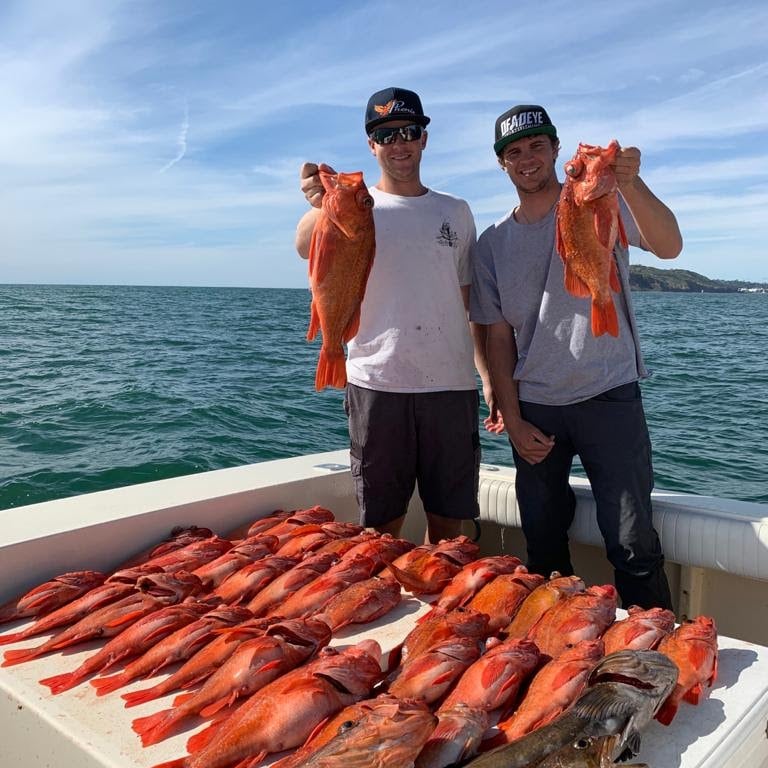Rock Fish
There are so many different kinds of rock fish that they are hard to keep track of, but dont worry... they all taste good.
Ocean's offerings are often made into tasty fish tacos. In fact it could be argued that the best fish taco on earth is made from this fish.
Did I mention they are also plentiful and easy to catch? Perfect for young anglers looking to start their careers.
Half day, 3/4 day, full day, that is all you need!
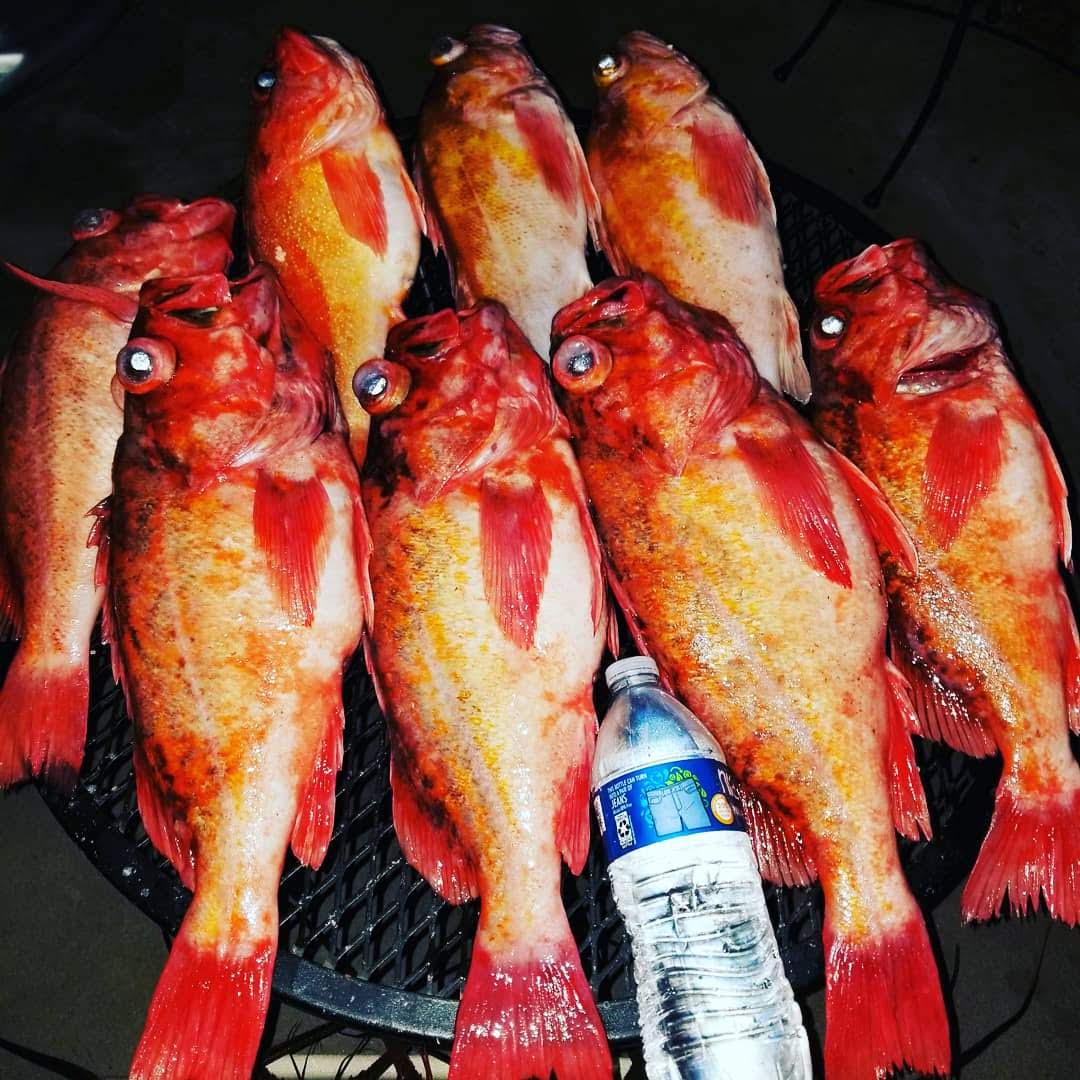
Small groups only!
Introducing Kids to Fishing with Rockfish
Rockfish are an excellent species to introduce kids to fishing, as they are generally easy to catch and can provide a fun and rewarding experience for young anglers. However, when targeting Rockfish in deep water or strong currents, heavier gear and more weight may be necessary to reach the desired depth.
Shallow Water Rockfish: A More Enjoyable Experience
In my opinion, targeting Rockfish in shallower waters is a more enjoyable experience, as it allows for a more interactive and engaging fishing experience. Although the larger Rockfish are often found in deeper waters, the shallows can still produce a good catch. To increase the chances of success, braided line is a must-have, as its low-stretch properties enable anglers to feel the bite even in deep water and make a solid hookset.
The Captain's Secret Spots
Our experienced captains have their favorite "honey holes" that they've discovered over the years, and they know exactly where to find the Rockfish. Using sonar to locate the fish, the captain will position the boat directly above the school and instruct you to drop your weighted hooks with live bait and/or squid right on top of them. This technique often results in multiple catches at once, with two fish on the line being a common occurrence.
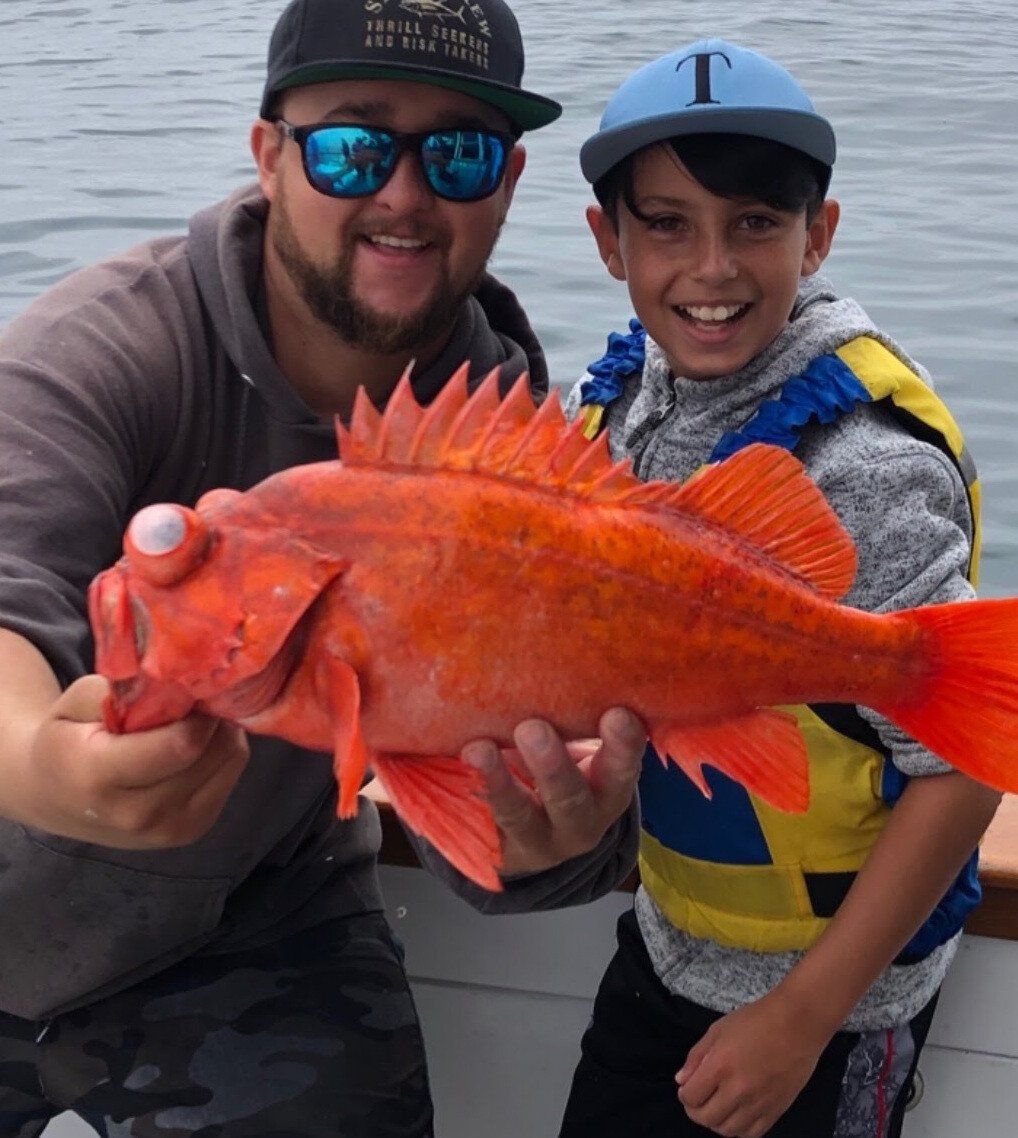
- Common Rockfish Species:
- Black Rockfish: The Black Rockfish is a deep-water species that can be found in waters as deep as 1,000 feet, and is known for its dark brown to black coloration with a distinctive white stripe.
- Blue Rockfish: The Blue Rockfish is a medium-sized species that is often found in rocky areas and kelp forests, and is recognized by its vibrant blue color and distinctive yellow fins.
- Brown Rockfish: The Brown Rockfish is a common species found in San Diego waters, and is characterized by its brown or tan coloration with a distinctive white stripe running along its sides.
- China Rockfish: The China Rockfish is a deep-water species that is often found in areas with rocky outcroppings, and is known for its distinctive orange-red coloration with white stripes.
- Copper Rockfish: The Copper Rockfish is a medium-sized species that is often found in kelp forests and rocky areas, and is recognized by its vibrant copper-colored body with a distinctive yellow stripe.
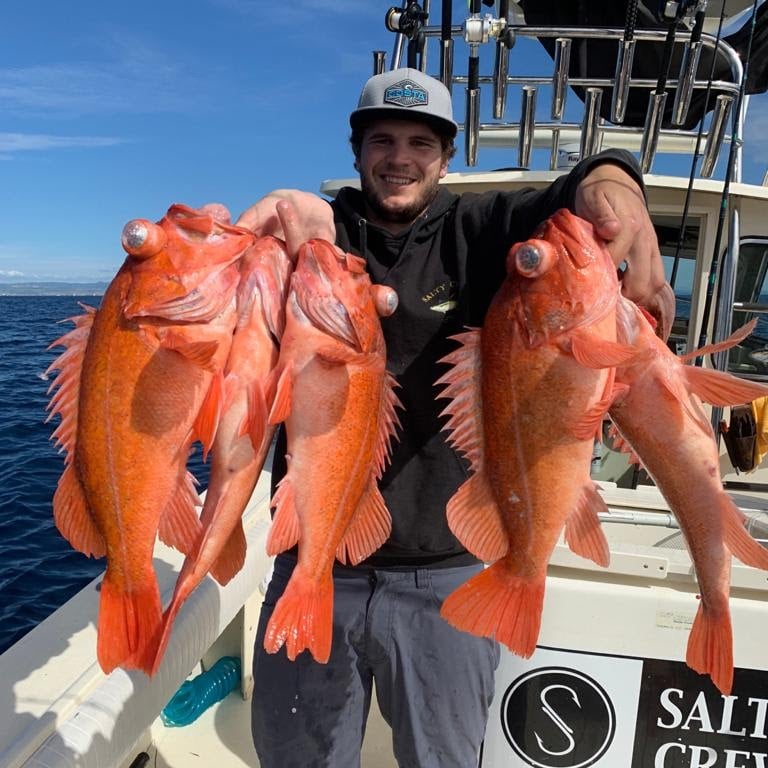
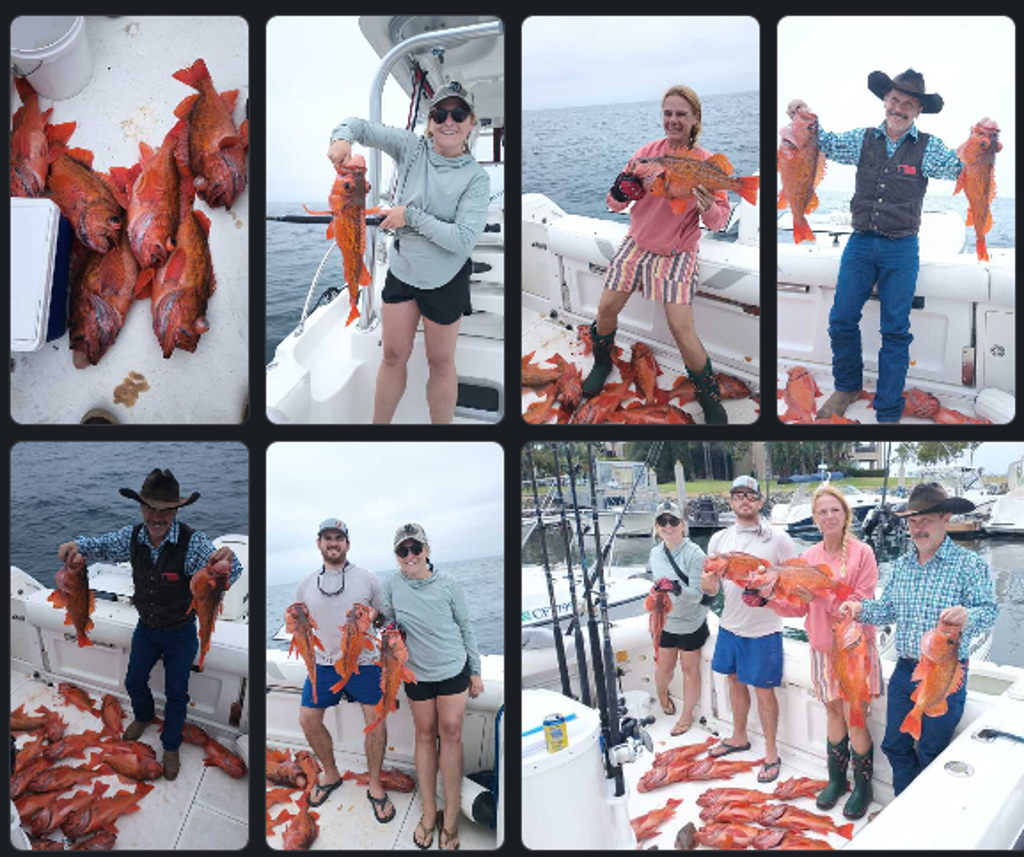
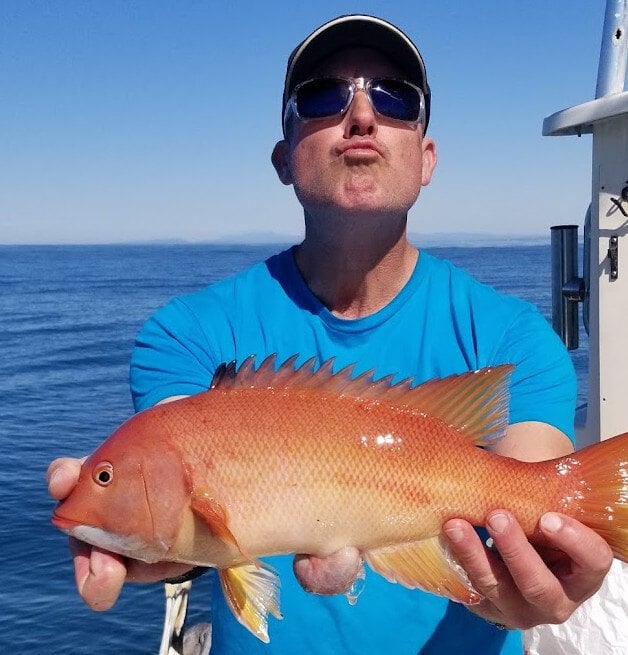
Rockfish Seasons
- Season: Year-round, with peak season from June to October
- Migration Pattern: Rockfish are a resident species in San Diego waters, and can be found throughout the year. They tend to congregate around rocky reefs, kelp beds, and other structures.
- Fishing Spots: Popular fishing spots for rockfish in San Diego include the kelp beds off La Jolla, Point Loma, and the Coronado Islands.
- Fishing Techniques: Rockfish can be caught using a variety of techniques, including bottom fishing, casting, and trolling. They are often targeted using lures such as jigs, spoons, and plugs.
- Size: Rockfish typically range in size from 1 to 10 pounds, with some larger fish reaching up to 20 pounds.
Fishing Regulations
- Bag Limit: The bag limit for rockfish in San Diego is 10 fish per day, with a minimum size limit of 12 inches.
- Season: The rockfish fishing season in San Diego is open year-round, but there may be closures or restrictions in place due to conservation efforts or other factors.
- Gear Restrictions: There are no specific gear restrictions for rockfish fishing in San Diego, but anglers are encouraged to use catch-and-release fishing practices and to handle the fish gently to minimize injury.
Tips and Techniques
- Bottom Fishing: Bottom fishing is a popular technique for catching rockfish in San Diego. Anglers can use lures such as jigs, spoons, and plugs to target the fish.
- Casting: Casting is another effective technique for catching rockfish in San Diego. Anglers can use lures such as jigs, spoons, and plugs to target the fish.
- Trolling: Trolling is a technique that involves using a lure or bait to target rockfish. Anglers can use this technique to target the fish in areas where they are known to congregate.
- Kelp Bed Fishing: Kelp bed fishing is a technique that involves using a lure or bait to target rockfish in kelp beds. Anglers can use this technique to target the fish in areas where they are known to congregate.
Migration Patterns
- Summer: During the summer months, rockfish tend to congregate in shallower waters, where the water is warmer and more nutrient-rich.
- Fall: During the fall months, rockfish begin to migrate to deeper waters, where the water is cooler and more stable.
- Winter: During the winter months, rockfish are less active, and tend to congregate in deeper waters, where the water is cooler and more stable.
- Spring: During the spring months, rockfish begin to migrate to shallower waters, where the water is warmer and more nutrient-rich.
Conservation Status
- Rockfish are a species of special concern in San Diego waters, due to overfishing and habitat degradation.
- The rockfish fishery in San Diego is managed by the National Oceanic and Atmospheric Administration (NOAA) and the California Department of Fish and Wildlife (CDFW).
- Anglers are encouraged to practice catch-and-release fishing and to handle the fish gently to minimize injury.
Tacos.
- Quillback Rockfish: The Quillback Rockfish is a medium-sized species that is often found in rocky areas and kelp forests, and is recognized by its distinctive brown or tan coloration with a distinctive quill-like dorsal fin.
- Red Rockfish: The Red Rockfish is a deep-water species that is often found in areas with rocky outcroppings, and is known for its distinctive bright red coloration with white stripes.
- Rosy Rockfish: The Rosy Rockfish is a medium-sized species that is often found in kelp forests and rocky areas, and is recognized by its distinctive pink or rose-colored body with a distinctive white stripe.
- Treefish: The Treefish is a small species that is often found in shallow waters, and is known for its distinctive tree-like pattern and vibrant yellow fins.
- Vermilion Rockfish: The Vermilion Rockfish is a deep-water species that is often found in areas with rocky outcroppings, and is known for its distinctive bright red coloration with white stripes.
- Yelloweye Rockfish: The Yelloweye Rockfish is a medium-sized species that is often found in rocky areas and kelp forests, and is recognized by its distinctive yellow eyes and vibrant orange-red coloration.
- Canary Rockfish: The Canary Rockfish is a medium-sized species that is often found in kelp forests and rocky areas, and is recognized by its distinctive yellow or orange coloration with a distinctive white stripe.
- Chilipepper Rockfish: The Chilipepper Rockfish is a deep-water species that is often found in areas with rocky outcroppings, and is known for its distinctive bright red coloration with white stripes.
- Gopher Rockfish: (Same as above)
- Pacific Ocean Perch: The Pacific Ocean Perch is a small species that is often found in shallow waters, and is known for its distinctive orange-red coloration with white stripes.
- Starry Rockfish: The Starry Rockfish is a medium-sized species that is often found in rocky areas and kelp forests, and is recognized by its distinctive star-like pattern and vibrant yellow fins.
- Tiger Rockfish: The Tiger Rockfish is a deep-water species that is often found in areas with rocky outcroppings, and is known for its distinctive orange-red coloration with white stripes.
- Widow Rockfish: The Widow Rockfish is a medium-sized species that is often found in kelp forests and rocky areas, and is recognized by its distinctive brown or tan coloration with a distinctive white stripe.
